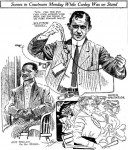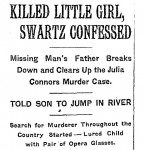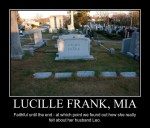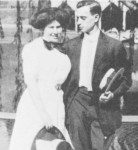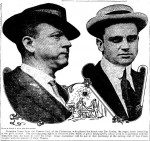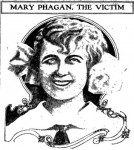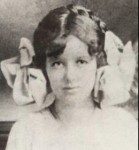The testimony of Jim Conley, the negro sweeper at the National Pencil Company, was a major portion of the second and third weeks of the Leo Frank trial. Cross-examination alone amounted to some 13 hours.
Returning to the Conley-related points in 100 Reasons Leo Frank Is Guilty, The American Mercury, by Bradford L. Huie:
55. Much is made by Frank partisans of Georgia Governor Slaton’s 1915 decision to commute Frank’s sentence from death by hanging to life imprisonment. But when Slaton issued his commutation order, he specifically stated that he was sustaining Frank’s conviction and the guilty verdict of the judge and jury: “In my judgement, by granting a commutation in this case, I am sustaining the jury, the judge, and the appellate tribunals, and at the same time am discharging that duty which is placed on me by the Constitution of the State.” He also added, of Jim Conley’s testimony that Frank had admitted to killing Mary Phagan and enlisted Conley’s help in moving the body: “It is hard to conceive that any man’s power of fabrication of minute details could reach that which Conley showed, unless it be the truth.”
The following points get at Frank and Conley’s special relationship before the murder:
81. The relationship of Leo Frank and the National Pencil Company to Jim Conley was a strange one. Why was Jim Conley’s sweeper’s salary much higher — $6.05 versus $4.05 — than the average of the white employees, many of whom were skilled machine operators? Could it be that Conley served a very important but secret purpose for Leo Frank, exactly as the prosecution alleged? Could he have had knowledge that could potentially hurt Leo Frank, justifying Frank granting him special privileges?
82. According to a female National Pencil Company employee, Jim Conley was once caught “sprinkling” (urinating) on the pencils, surely a very serious offense. But Conley was never fired. (Trial Testimony of Herbert George Schiff, Brief of Evidence, Leo Frank Trial, August, 1913) Again, could it be that James Conley served a very important but secret purpose for Leo Frank, and could he have possessed knowledge that could damage Frank?
83. According to fellow employee Gordon Bailey (Leo Frank trial, Brief of Evidence, August, 1913) Jim Conley was not always required to punch the time clock. Why would the “Negro sweeper,” as they called him, surely the lowest-ranking employee in the pencil factory hierarchy, be given such an unprecedented privilege by Leo M. Frank? Why was Jim Conley the only person out of the 170 factory employees who didn’t have to punch the time clock — unless Jim Conley was more than meets the eye?
The Leo Frank Trial: Week Two, The American Mercury, by Bradford L. Huie:
Prior to the trial, Jim Conley had made one admission after another under the withering blast of police interrogation. He would make three statements in all, in each one admitting to more and more participation in the crime. Despite his slow, reluctant, and grudging admissions — and the obvious contradictions among his initial affidavits — investigators, and even some who had been doubtful about Conley’s account, were finally convinced that they had gotten the truth out of him. Police and factory officials accompanied Conley when he was brought back to the scene of the crime. Conley guided them through the factory and recounted and re-enacted the events of April 26, 1913 — the day of the murder — step by step as he had experienced them. The account was so minute in its details, so consistent with the known facts, so precisely matched with evidence which Conley could not possibly have known about unless he had really been there, and presented in such an open and frank manner that even skeptics were convinced by it.
Conley’s own explanation:
As to why I didn’t tell it all, I didn’t want to tell it all. I was intending to hold back some. I didn’t want to tell it all right at one time. I just told a little and kept back a little. Yes, and Mr. Dorsey went down seven times while I was telling some and holding back some. They didn’t ask me to take back any stories. No, it didn’t take Mr. Dorsey seven times to tell the story. Yes, I said I added to it every time he went down. But he wouldn’t came back and try to do anything with it.
Frank’s defenders had their chance to question Conley, and the jury still found him credible:
Conley held up well under the ferocious attack of the defense. He freely admitted that he had been confused on a few occasions and had lied in his first two statements — first, to protect himself, and second to protect Frank, who he still expected would come up with bail money and get him out of town — and he also provided a wealth of new detail about Leo Frank’s “chats” with young women.
Frank’s defenders tried to play one group of goyim against another:
At one point, Frank’s attorney Luther Rosser, referring to the recent haircut and clean set of clothes that Conley had been given, snidely remarked “They put some new clothes on you so the jury could see you like a dressed-up nigger” — possibly inflaming racial feelings among the all-White jury. It was widely believed at the time that Conley would be disbelieved by many simply because he was black and because Leo Frank, a white man, and Frank’s attorneys would contradict Conley and accuse him of the murder — a woe be unto any black man in 1913 Atlanta accused of harming a white girl.
Nevertheless Conley, a simple and poorly educated man, gave not an inch on his most damaging claims against Frank even when the most skilled attorneys money could buy cross-questioned him for more than 13 hours.
The Leo Frank Trial: Week Three, The American Mercury, by Bradford L. Huie:
Herbert G. Schiff, the factory’s assistant superintendent directly under Leo Frank, then testified, stating that he’d never seen women brought to the office as the prosecution had alleged, nor had he seen Conley “watching” for Frank. He stated that he, not Frank, had paid off Helen Ferguson the Friday before the murder, and that Ferguson has not asked for Mary Phagan’s pay. He also went into excruciating detail — thousands of words’ worth — about how the books were kept at the factory, with the unstated implication being that Frank would have simply been too busy calculating sums and making entries to have entertained young ladies — or killed them. This “too busy” line of reasoning would be returned to again and again by the defense, and would form the larger part of Leo Frank’s own statement in his own defense. It was reinforced by the next witness, public accountant Joel Hunter, and yet another accountant, C.E. Pollard.
Several workers at the factory, testifying for the defense, said they’d never seen Leo Frank talking to Mary Phagan, that they’d never seen him with women in his office after hours, and that Conley’s reputation for veracity was bad. One of them, Iora Small, went further, volunteering for the benefit of the all-white jury that “I don’t know of any nigger on earth that I would believe on oath.”
Prosecution witnesses claimed they saw X. Rather than directly attack the veracity of that testimony the defense tried to cloud the issue by producing witnesses who claimed they didn’t see X. The jury, who heard both sides in full detail, found X more credible than not-X.
The motives of Frank’s defenders, including the witnesses who testified in his favor, have at least three components: ethnic jewish loyalty, employer/financial fealty, and “white” racial solidarity (i.e. Whites mistaking jews as comrade “whites”).
The lengthy parade of sworn witnesses, called by both sides, is itself mute testimony to the fact that Leo Frank, vice president of his college debate club, would not testify under oath so as to avoid direct questioning in front of the jury.
A comment on Part 5 directed me to Carlos Porter’s opinion on Frank, LETTER 29 FROM CHICAGO DAVE: SKUNKIE AND THE LEO FRANK FILE:
In my view there is no real evidence against [Leo] Frank. All the so-called evidence comes from Conley, the man who wrote the notes found with the body, and who was CONVICTED AS AN ACCESSORY TO THE MURDER. No attempt was made to imitate the victim’s handwriting, but the police were supposed to find the notes, believe they were written by the victim during commission of the crime, and throw suspicion on a “long tall black negro” (Conley was short and powerfully built).
The police weren’t stupid enough to believe that the victim wrote the notes, but they were stupid enough to believe Conley when he claimed that Frank “dictated” the notes. Why the hell would Frank do that? How the hell COULD he do that? Would you do that if YOU committed a murder? Then they were stupid enough to coach Conley in his testimony for weeks and months to frame Frank for the murder! There is no question that Conley wrote the notes.
Whoever wrote those notes committed the murder. Conley could commit the murder without Frank, but Frank could not commit the murder without Conley.
Frank produced almost 40 witnesses who testified that Conley was a notorious liar. He was also a habitual petty criminal and drunkard who had been on the chain gang several times.
I repeat: if you committed a murder, would YOU write notes like that? Would you DICTATE notes like that? COULD you dictate notes like that? Would you believe a semi-literate drunkard who claimed he wrote those notes because they were dictated by an educated man?
It proves that people believe what they want to believe, regardless of the evidence.
They convicted him to show that “Georgia justice cannot be bought and sold with Jew money from New York”.
I don’t entirely trust anything on the Internet about the Frank case. In most ways, the commutation file is the best.
Porter links to his transcription of a scanned version of Governor John Slaton’s typewritten commutation of Frank’s sentence:
Read the files, OK, there are 29 of them, but there’s not much text on each page. [Note: I transcribed them.]
Appended to this transcript, governor slaton – leo frank commutation file, is a concise summary of Porter’s opinion:
The circumstantial evidence, in my mind, is inconclusive; so is the character evidence. If Frank had been convicted on circumstantial evidence alone, the case would be unclear. The evidence provided by Conley — particularly, the death notes — proves, in my view, that Frank’s guilt is not only out of the question, but absolutely impossible.
That’s the way I feel today, and I’ve felt that way for 30 years.
From the arguments and evidence I have considered so far, I think Frank was guilty. I’m still willing to examine arguments and evidence to the contrary, but in this case the notion that inconclusive evidence can prove anything, much less prove it absolutely, seems particularly ridiculous.
Porter’s argument in favor of Frank is reminiscent of Johnny Cochran’s infamous closing argument in defense of O.J. Simpson: “if it doesn’t fit, you must acquit”. The gist of it is to focus on one aspect of the prosecution’s case, claim there is something wrong with it, and jump to the conclusion that the defendent must be innocent.
Stephen Goldfarb used a similar kind of illogic in “Framed” (discussed in The Murder of Mary Phagan – Part 4). Goldfarb makes the outrageous attempt to paint Harry Scott and Hugh Dorsey as scoundrels in order to exhonerate Frank. Porter selects Conley, a far easier mark, for the same end.
The essence of Porter’s argument is: 1) Frank was convicted only because of Conley’s testimony, 2) Conley wrote the murder notes, 3) Conley was a liar, 4) Conley lied about Frank dictating the murder notes, therefore 5) “Frank’s guilt is not only out of the question, but absolutely impossible”.
Point 1, Porter’s assertion that “there is no real evidence against [Leo] Frank. All the so-called evidence comes from Conley”, is plainly false. Conley’s testimony played a critical, perhaps even decisive role in Frank’s conviction, but it was not the only evidence presented against Frank. Frank was arrested and indicted before it was known who wrote the murder notes, much less who conceived them or why. Porter himself points approvingly to Slaton, who described other important evidence against Frank that was unrelated to Conley.
Points 2 and 3 were conceded by Conley and known to the jury.
Point 4 is the heart of Porter’s argument. It is indeed plausible that Conley decided what to write. Frank may have only suggested that Conley write something implicating someone else. Conley might have even come up with the idea himself. Perhaps at first Conley understood the notes as a way to help save his boss, but lied about in court to help implicate his boss because by then it had become clear he needed to save himself.
So what? Even if there is truth in such speculation, it is not necessarily incompatible with the rest of Conley’s story, much less the prosecution’s overall case against Frank.
Podcast: Play in new window | Download





